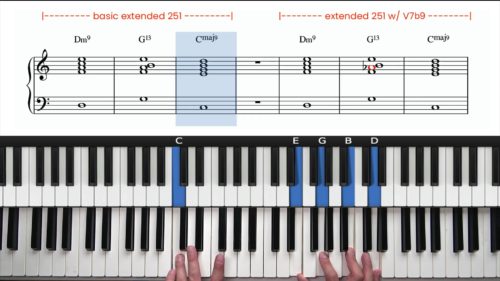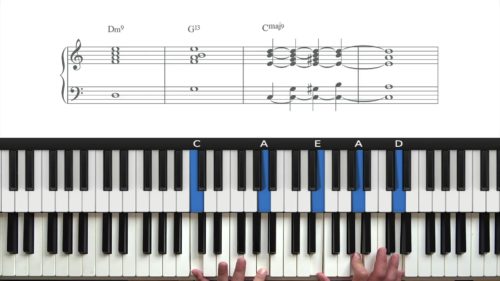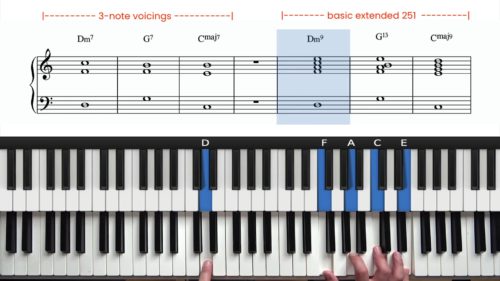Major 251 Drill For Beginners
Mastering this 251 drill is the most important exercise in the Jazz Piano Foundations course. Virtually every jazz standard contains a 251 in some form and so once we are comfortable identifying and playing the 251 progression we have strong foundations in place.
Type A & Tpe B Voicings
Each progression can be played in “Type A” where we start on the ii-7 chord with the 3rd on the bottom, and “Type B” where we start on the ii-7 chord with the 7th on the bottom.
Remember that the voice leading is always the same – the 7th falling to the 3rd of the next chord – and this takes place at the top or at the bottom of the voicing.
Don’t Become Reliant On Notation!
The full notation for these progressions have been provided in the download section but try not to become overly reliant on the notation. It’s vitally important that we can find the notes of each 7th chord on the piano and also visualise the voice leading of 7ths falling to 3rds.
Lesson Downloads
-
Whole Step 3-Note 251s – Type A File Type: pdf
-
Whole Step 3 Note 251s – Type B File Type: pdf
Practice Tips
-
If you struggle with any of these 251 progression, revisit the previous lesson in this course where we drill the scale, triads, and 7th chords of each key.
-
Once you have mastered this drill, move onto the other drills in the whole step 251 course - https://www.pianogroove.com/jazz-piano-lessons/whole-step-251-exercises/
-
Pay attention to the voice leading so that you can clearly visualise 7ths falling to 3rds in each 251 progression.






On the top of both download sheets, they say Type A. I believe the second download sheet should say Type B at the top
Hi Andrew,
Thanks for letting me know about this. I have fixed the issue.
The notation was indeed correct, just the wrong title.
Have fun practicing this stuff!
Cheers, Hayden
I’m confused as to when one plays the 5 note in the LH going up or down from the 2 note.
In the Drills PDF for this exercise, all of the Type A 5th notes are played up and all of the Type B 5 notes are played down, except for the D and E scales of Type B which are played up.
Is there are reason for this or is it up to the pianist depending on what “sound” they’re after? I noticed some variation on this in the lessons but it was never explicitly addressed as to whether it matters.
Thanks
Hi Bob.
Great question here and apologies for the late reply.
The 5th is always an optional note. Remember that it’s the 3rd and the 7th that define the harmony, ie. is the chord major, minor, or dominant.
The 5th adds more weight to the chord, which can be a good thing. I recommend to practice both variations with and without the 5th.
Completing these drills without the 5th will focus all of your attention on the 3rds and 7ths which are the most important tones from a voice leading standpoint.
Once you have completed this lesson, I recommend to check out the course on “Whole Step 251 Drills” where we introduce more advanced theory such as chord extensions, chord alterations, and other interesting devices, you can find that course here:
https://www.pianogroove.com/jazz-piano-lessons/whole-step-251-exercises/
I hope that helps Bob, and let me know if you have any further questions.
Cheers, Hayden
What do you see as the benefit of doing whole step 251 practice versus circle of 5th 251 practice? I’ve done some of both in the past and I want make sure I know what patterns or relationships I should be focusing on when doing the two different drills. Thanks!
Hi JP,
Good question.
Both drills have their merits so I recommend both circle of 5th drills, and whole step drills.
Personally, I find that the Whole Step 251 Drill is really great for visualising specific inner movements, for practicing extended voicings, and for targeting specific alterations.
One of the benefits of the Whole Step Pattern is that we can work through 6 keys without lifting our hands off the keyboard. This improves the efficiency of our practice.
Another plus is that harmony moving in whole steps can be found in jazz standards, take the tune “How High The Moon” as an example: https://www.pianogroove.com/live-seminars/how-high-the-moon-jazz-standard/
And so practicing the whole step drill will help you to become more familiar with this type of harmonic movement commonly found in jazz standards.
I hope that helps JP, and let me know if I can be of further assistance.
Cheers, Hayden
Okay….so I’m not crazy or just lazy! I have relied on my memory of shapes and positions of my fingers with chords my entire life. It’s like muscle memory for Steph Curry with his awesome three-point shooting. Once you practice it enough and know what that release feels like, you automatically know it’s going in the hoop. Bottom of the net! I always felt like I was lazy for practicing this way.
My biggest challenge now is making myself call out what I’m playing so that I know what it is I’m playing. Also another thing that can be a hindrance for me I guess is that I sing and I know what these progressions actually sound like. So it’s tempting for me to just “sound it out” rather than doing the work to know the names of what I’m doing.
Uhhhh! Y’all say a prayer for me! LOL! Does anyone get where I’m coming from with this??
Hi Hayden I am working on 251 ‘s now trying to catch up and learning to read lead sheets. 🎶🤬 Sue Lewis
Hi, I’m still getting used to the basics of the web site. Where do the practice PDFs go when I download them? Is there a place in the web site or do I access them from somewhere else?
Hey Eric,
What device are you using to access the website?
It sounds like you could be using a tablet/touch screen device, in which case we usually have a “Files” application (on iPhone/iPad at least) where all downloads are automatically saved.
If you are using a laptop, you will see the download appear in the browser window.
To answer your question, the downloads are not stored on the website, they are being downloaded and saved to your device, you just need to find out where they are being saved.
If you let me know the make and model of your device, I will help you figure that out.
If you are using an Apple device, search or look for the “Files” application and the downloads should be saved in there.
Talk soon, Hayden
Hi Hayden, thanks. I’m using an Apple iPad and my iPhone. I don’t know if this is the best way to save and view the lesson PDFs but found a way to download and organize them using Apple Books. enhowland/Eric
Awesome, glad to hear it Eric!
Talk soon, Hayden